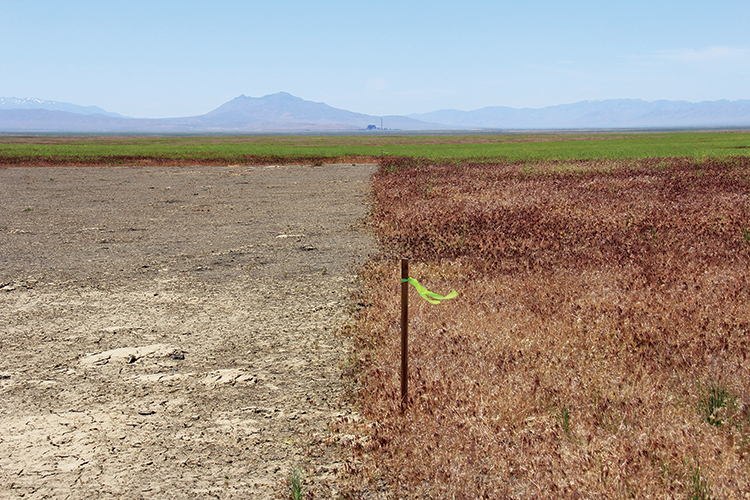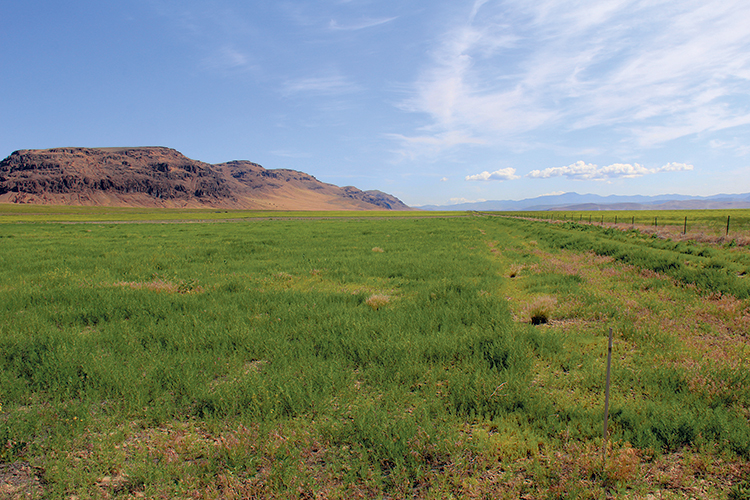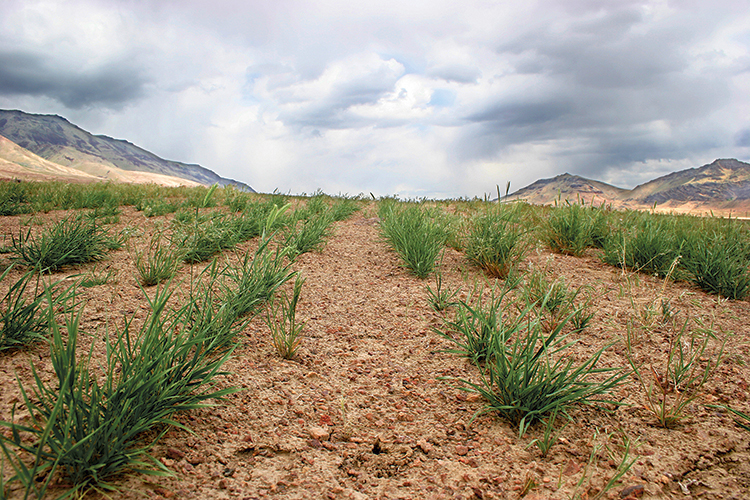 Weed control has been a concern of farmers since agriculture began. The use of herbicides to control weeds only came into wide use in the first half of the twentieth century. The first half of the twentieth century produced new herbicides and new methods of administering them. Scientists tested a variety of compounds and formulations to test on the control of various plants and plant types, and some of this testing was quite extreme. Dr. Alden Crafts, noted weed scientist and instructor at the University of California at Davis, told his introductory weed control class in 1955 that the only discomfort he ever suffered while applying herbicides occurred when he was experimenting with sulfuric acid application for weed control in onion fields. The real big breakthrough in herbicide development occurred in the 1930s when the phenoxy compound that regulates plant growth was discovered. This discovery resulted in the development of the very popular 2,4-D (2,4-dichlorophenoxy acetic acid), which initiated a revolution in chemical weed control. Before World War II, farmers spent an estimated $1.5 – $2.5 million annually on herbicides, within two decades following the war herbicides constituted a $250 million industry in the United States. As early as 1944, 2,4-D was reported to effectively kill bindweed within 10 days of application, and the news of this success spread rapidly. The characteristic that made 2,4-D unique as an herbicide was its’ physiological selectivity; it acted only on broadleaf plants. Therefore, it could be applied on cereal grain crops (grasses) without harming them, yet selectively killing the competing broadleaf weeds. Similarly, it could be applied to excessively dense stands of big sagebrush to release the remnant stands of perennial grasses. Early researchers, however, faced the challenges of using herbicides to kill cheatgrass, while not injuring the perennial grasses needed to suppress cheatgrass. Pioneer researcher, Richard Eckert, range scientist with the USDA-Agricultural Research Service, Great Basin Rangelands Research Unit was tasked with the application of numerous herbicides to control cheatgrass while at the same time increasing perennial grasses.
Weed control has been a concern of farmers since agriculture began. The use of herbicides to control weeds only came into wide use in the first half of the twentieth century. The first half of the twentieth century produced new herbicides and new methods of administering them. Scientists tested a variety of compounds and formulations to test on the control of various plants and plant types, and some of this testing was quite extreme. Dr. Alden Crafts, noted weed scientist and instructor at the University of California at Davis, told his introductory weed control class in 1955 that the only discomfort he ever suffered while applying herbicides occurred when he was experimenting with sulfuric acid application for weed control in onion fields. The real big breakthrough in herbicide development occurred in the 1930s when the phenoxy compound that regulates plant growth was discovered. This discovery resulted in the development of the very popular 2,4-D (2,4-dichlorophenoxy acetic acid), which initiated a revolution in chemical weed control. Before World War II, farmers spent an estimated $1.5 – $2.5 million annually on herbicides, within two decades following the war herbicides constituted a $250 million industry in the United States. As early as 1944, 2,4-D was reported to effectively kill bindweed within 10 days of application, and the news of this success spread rapidly. The characteristic that made 2,4-D unique as an herbicide was its’ physiological selectivity; it acted only on broadleaf plants. Therefore, it could be applied on cereal grain crops (grasses) without harming them, yet selectively killing the competing broadleaf weeds. Similarly, it could be applied to excessively dense stands of big sagebrush to release the remnant stands of perennial grasses. Early researchers, however, faced the challenges of using herbicides to kill cheatgrass, while not injuring the perennial grasses needed to suppress cheatgrass. Pioneer researcher, Richard Eckert, range scientist with the USDA-Agricultural Research Service, Great Basin Rangelands Research Unit was tasked with the application of numerous herbicides to control cheatgrass while at the same time increasing perennial grasses.
From 1950 to 1960, numerous new chemical compounds were discovered and released for testing to improve weed control practices. Herbicides enter the plants either through aerial portions, primarily leaves, or through the roots. Therefore, these herbicides are classified as foliar or soil active. At that time, 2, 4-D would be a good example of a foliar herbicide while atrazine would be a good example of a soil active herbicide. Early in the development of an herbicide to control cheatgrass, researchers reported that the soil active herbicide, siduron, was effectively killing cheatgrass seedlings, while not harming perennial wheatgrass seedlings in greenhouse experiments. When Richard Eckert applied siduron in field experiments, both cheatgrass and perennial wheatgrass seedlings experienced high mortality. The reason behind this was that the greenhouse studies had left the soils moist, while that was not the case in the field study sites of the arid Great Basin. Raymond Evans, Research Leader for the USDA-ARS Great Basin Rangelands Research Unit at the time, was a pioneer researcher in seed and seedbed ecology. Evans conducted greenhouse experiments followed up by field experiments that simply pointed out that near total control of cheatgrass was necessary for the survivability of perennial grass seedlings. Lacking the selective herbicide that would control cheatgrass and allow perennial wheatgrass seedlings to establish, Evans and Eckert started planning for a strategy to control cheatgrass and establish perennial grasses. Soil active herbicides that would kill cheatgrass left behind an active residue in the soil that would also kill the perennial grass seedlings. So, they started testing the application of soil active herbicides on treated areas, allowing the herbicide treated areas to remain bare for a season after the herbicide application, therefore allowing the toxic residues to leach away or be broken down by sunlight and/or microbial degradation, otherwise known as fallowing. The key to fallowing a site is keeping the land free of all vegetation so that the soil stores moisture and accumulates nitrates (Fig. 1).
From 1958 through 1966, Evans and Eckert conducted research trials using eighteen different soil active herbicides at seven separate locations in Nevada and northeastern California. The evaluated the herbicides for 1) control of cheatgrass, 2) control of associated weeds, and 3) influence of herbicide residues on perennial grass seedlings. Although it is obvious that controlling cheatgrass and not harming perennial grass seedlings are the main goals, the inability of herbicides to effectively control associated weeds in these application trials is often overlooked. Even today, soil active herbicides that are not effective in controlling associated weeds such as Russian thistle and tansy mustard experience difficulties in establishing perennial grasses. Timing is the critical issue in this evaluation because if there is not enough herbicide residue or the herbicide does not have the spectrum of activity to control these associated weedy species, they will grow luxuriantly during the fallow year and no moisture or nitrate will be stored in the soil that would benefit perennial grass seedlings.
One of the soil active herbicides Evans and Eckert identified as a good candidate was atrazine. They summarized their findings as “activity of atrazine was long enough for consistent season long control of downy brome (cheatgrass) under conditions that existed on all years of the study. Atrazine also controlled a wide spectrum of weeds found in these experiments.” The one example was Russian thistle that grew on one of their plots following exceptional summer precipitation (Fig. 2). Atrazine was applied in the fall of the year so that winter moisture would move it into the surface of the soil where cheatgrass seed banks were located. The basic sequence of events for the atrazine fallow was to apply 1 pound per acre of active ingredient of atrazine in mid to late fall, fallow the site through the next year, resulting in bare soil and increases in moisture and nitrate in the soil, and then seed the site to perennial grasses the fall after the fallow year (10-12 months after application).
The next year was the seedling year for the seeded species, which was not grazed until after seed ripe to allow for initial establishment (Fig. 3). Seeded perennial grass densities were very impressive, but Evans and Eckert did see signs of areas of mortality due to continued residue activity. In response, further research yielded that by reducing the atrazine rate from 1 pound per acre down to 0.50 pound per acre, atrazine was still effective in controlling cheatgrass and also yielded higher seedling densities of seeded perennial grass species. This basic sequence and approach have laid the groundwork for our research of using various soil active pre-emergent herbicides to effectively control cheatgrass while at the same time conducting plant material testing on numerous perennial grasses shrubs and forbs in our efforts to restore and rehabilitate degraded Great Basin rangelands for more than three decades.
Atrazine’s relative insolubility contributed to the presence of residues of herbicide activity during the seedling year continued to be of concern. It was reported that crested wheatgrass seedling establishment was better if a semi-deep furrow drill was used for seeding. Added research reported that replicated experiments also yielded better grass establishment when seeded in furrows than on flat seedbeds. Measurements of soil moisture indicated that the microenvironment at the bottom of the furrow held more moisture than the surface. The superiority of furrow seeding was even more pronounced on atrazine fallows, and it was reported that that there was less evidence of herbicide injury to perennial grass seedlings growing in the furrows. It gradually became apparent that that the furrow action was moving the surface soils contaminated with atrazine away from the seeded row and the seed was being planted below the areas where the residues occurred. Laboratory experiments later demonstrated that the loss of the litter on atrazine fallows eliminated the safe site cheatgrass germinates so well in.
Evans and Eckert went from testing the herbicide fallow technique in small plots in the 1950s and 1960s to testing this technique on 1,000-acre demonstration plots in the 1970s. The herbicide was applied aerially, fallowed for 1-year and seeded with rangeland drills. In cooperation with the herbicide manufacturer, they evaluated the fate of herbicide residues. All requirements for registration of atrazine for herbicidal fallows on rangelands were met or exceeded. Within the natural constraints of the Great Basin environment for perennial grass seedling establishment, grasshopper infestations, droughts, trespass cattle and Mormon cricket outbreaks, the atrazine fallow was an unqualified success for seeding for big sagebrush/bunchgrass communities converted to cheatgrass dominance. The success of the atrazine fallow was embellished for special applications where small amounts of broadleaf herbicides, such as picloram, which had both foliar and root uptake by some plants, provided a means of controlling Scotch thistle and other broadleaf weeds in seedbeds at the same time annual grasses were being suppressed. This basic herbicidal fallow could also be used to aid in the establishments of transplants of valuable native shrubs like antelope bitterbrush. This progressed to weed control/revegetation systems for big sagebrush rangelands that resulted in revegetation with perennial grass and native shrub mixtures.
Richard Eckert also experimented with the application of atrazine over existing crested wheatgrass seedings in an effort to further control cheatgrass and release limited resources to the existing perennial grasses. Eckert reported that the application of atrazine over existing crested wheatgrass plants did not harm the existing bunchgrass, and that the added soil moisture and nutrients released during the fallow year increased crested wheatgrass seed production and improved seedling establishment the fallowing spring after the herbicide residue activity had subsided.
Although there was real progress being made at solving rangeland weed issues with the use of herbicides, environmentalism was born in the wake of Rachel Carson’s Silent Spring which aroused a general public outcry about the potential dangers of widespread use of pesticides in agriculture. It made no difference that most of the environmental disasters that were described involved pesticides and not herbicides. Secondly, the passage national environmental laws brought democracy to natural resource management, especially on public lands. Prior to the passage of these laws, management strategies were commodity driven, with the ranching, timber, or mining interest providing the majority of the input. Creating more forage for livestock on Great Basin rangelands was no longer a primary goal. Public land management agencies did not drop the use of herbicides because they were afraid of the environmental consequences, they dropped them because they were afraid of the comments from the highly vocal general public. Congress stopped appropriating funds for the improvement of publicly owned rangelands to avoid criticism from environmental groups. The private ranching sector should have welcomed the new technology as a means of converting their own rangelands from cheatgrass dominated to perennial grass dominated rangelands to provide dependable forage as well as reduce wildfire risks associated with cheatgrass. Public land management agencies responded to the new national environmental review regulations, not with compliance, but by trying to avoid them. Coupled with reduced funding for range improvement practices, this policy replaced range improvement practices with grazing management. It took a good two decades to reinvigorate the need for herbicidal weed control research to add to the toolbox of range improvement practices needed to combat cheatgrass infested rangelands.
Figure 1. A perfect example of the use of a soil active herbicide to control cheatgrass and store moisture and nitrate in the soil for the establishment of seeded perennial grasses.
Figure 2. Soil active herbicides that lack the spectrum of broadleaf weed control following cheatgrass control can expect limited success in establishing seedlings of seeded perennial grass species, as the broadleaf weed densities reduce available soil moisture and nitrogen needed for seedling survivability.
Figure 3. The effective control of cheatgrass control is paramount in perennial grass seedling establishment on arid Great Basin rangelands. Soil active herbicides play an essential role in successful restoration/rehabilitation efforts.
By Charlie D. Clements, James A. Young and Dan Harmon



